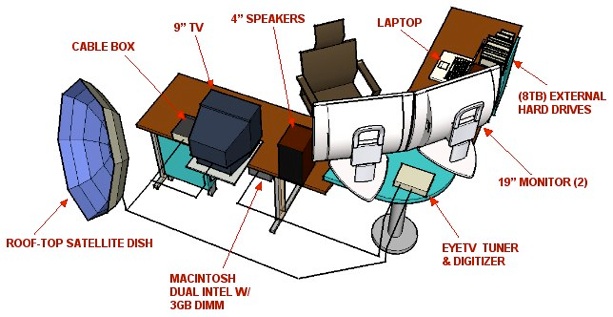How To(ols)

TOOLS: I work entirely alone. Above is a mediated 3D view of my home studio. This representation was constructed with Google’s free and simple-to-use modeling program: Sketch-Up. My studio is about 8‘x10’. I sit here 10-12 hours almost every day. Besides my books, the tools I use for making critical montage are most likely the same non-exotic items found in many Western homes. This is a deliberate choice in my research, since the entire premise of Cultural Farming is to encourage anyone willing to participate. I have cable TV and internet broadband through a roof-top satellite dish in order to receive American TV news channels in Canada. I have a five year old computer with external speakers and a small, even older TV. I have huge hard-drive storage capacity (8TB) because video files are large. I retain a personal internet server with unlimited uploading capacity, which costs a small annual fee. And I have a $200 item called EyeTV. It is a digital converter/tuner that streams TV directly onto my computer screen for capture. I’m certainly not tech-geek savvy, so luckily connecting and operating all my tools is rather straight forward. And lastly, importantly, I have one small window (screen?) that looks upon one of the most clean and beautiful rivers in Canada... the Bow River.
On one hand, the items listed above add up to a lot of technology. On the other hand, these few and simple tools can and should be contrasted to the seldom scrutinized technical fetishizations exhibited throughout all of media production as well as anthropological visual ethnography; which in itself suggests Cultural Farming’s purpose is conducive to more civic, democratically discursive possibilities; possibilities that carry well beyond conceits of ‘social participation’ via mere uploading to YouTube.
...so then, once situated, all that remains is to stop “watching” TV and start looking closely and critically for extended periods of time -- as if you were obliged to reply. Then... ‘grab’ particular clips that attract (repetitively or similarly, normatively or exceptionally, viscerally or intellectually, orally or aurally or visually). Import combinations of these clips into iMovie...
- see - edit - mash - think - show - learn - write -
...and then go read some more theory and learn through mixing again. Build your own critical voice and grow your own media. Teach your brain to see/think differently, because your brain eats what your body senses. And be sure to take time to sing this while you do it. Why-o? Be-cause. It helps wash away the accumulative effects of the mountains of difficult images involved in dangerous farming.





The tools used for creating Cultural Farming....
As Dziga Vertov wrote, films should be “as useful as shoes”.
Stam, Robert. (2000). Film theory: An Anthology. New York:Wiley-Blackwell. (p:46).
Cultural Farming is a practical-intellectual-civic media project. It is for helping build our ability to see, appreciate, interpret and create TV content, by purposefully re-telling the media stories told to us everyday. Thus, it is also a means of public “checks-and-balances” to help TV mediamongers see and hear their own work differently. Cultural Farming methods are:
Archiving (camera/screen) media content reflectively and reflexively for purposefully
evaluating both ourselves and our world by regarding the experiences of, the
reliabilities in, and our pleasures from this range of media... And then, by publicly
Responding to this range of media in ways (remediated images + text) that advance
thinking, decision making and communication practice.
Why attempt to do this via blatant (rip/remix) appropriation of existing TV/media content? To paraphrase train-robber Willie Sutton: Cultural Farmers do it because television is where
the (cultural) tele-visual practices are... and because, whether we care to admit it or not, television -- in all its surrealism -- remains the primary docent to all camera/screen storytelling.
{
}
{
}
An American
resident of Canada, experimenting with new forms of critical media ethnography in Cultural Farming.
uploaded : 2009


